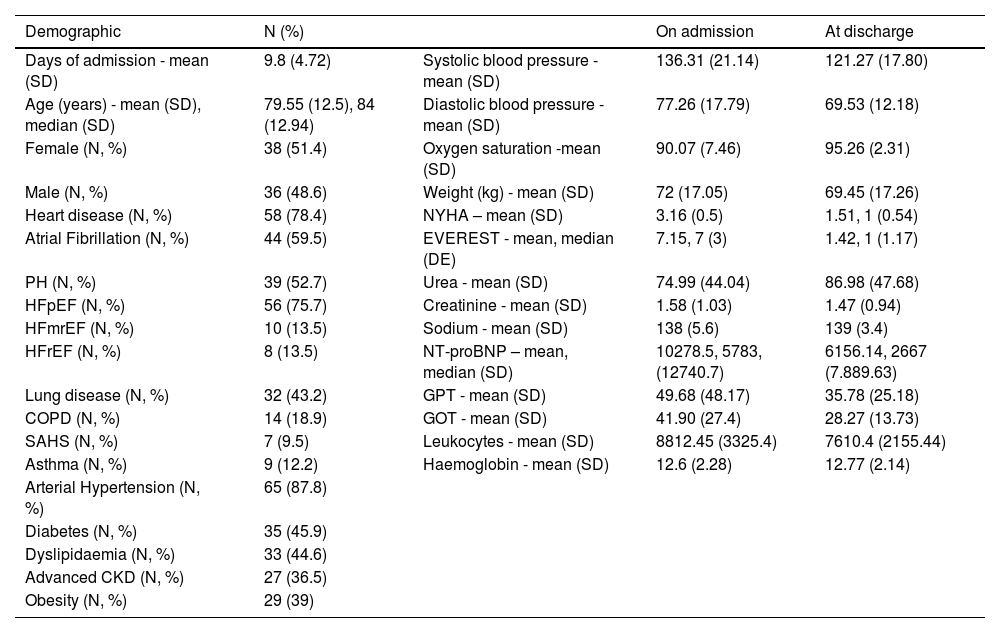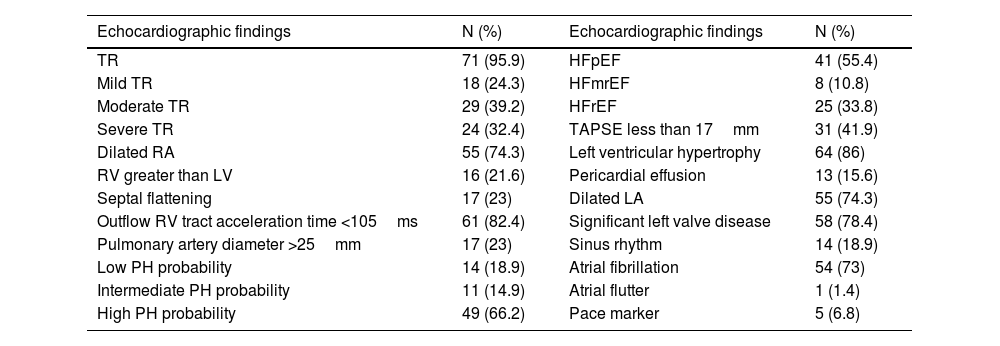The aim of our study is to define the role of Pulsed-Doppler (PW-Doppler) Ultrasound of the Common Femoral Vein (CFV) in the assessment of dilatation Inferior Vena Cava (IVC), probability of Pulmonary Hypertension (PH), Tricuspid Regurgitation (TR), and Tricuspid annular plane systolic excursion (TAPSE).
MethodsThis is a prospective two-hospital study in 74 patients admitted with acute heart failure (AHF). We performed PW-Doppler ultrasound of the common femoral vein, Point of Care (POC) cardiac ultrasonography and assessment of the IVC at the time of admission, as well as PW-Doppler and ultrasound of the IVC at hospital discharge.
ResultsThe detection of a pulsatile flow (138 scans) had an excellent ROC curve for the detection of IVC greater than 2cm (AUC 0.931, Sn 95%, Sp 90%, PPV 93%, NPV 94%) with an Odds Ratio (OR) of 211.2 (95% confidence interval 48.13–926.72). The pulsatility of the flow also had the highest performance in the detection of PH (AUC 0.8, Sn 95%, Sp 64%, PPV 84%, NPV 84%) and in the detection of moderate-severe TR (AUC 0.79, Sn 95%, Sp 67%, PPV 88%, NPV 78%). If the flow is continuous, we can reasonably rule out diminished TAPSE (NPV 89%).
ConclussionDetection of PW-Doppler flow of the CFV may be an alternative window for the detection of an IVC dilation of 2cm, significant TR, and the likelihood of high PH in acute heart failure. It also allows us to reasonably rule out dysfunction of the right ventricle in cases of normality in these patients.
El objetivo de nuestro estudio es definir el papel de la ecografía doppler pulsada (PW-Doppler) de la vena femoral común (VFC) en la evaluación de la dilatación de la vena cava inferior (VCI), la probabilidad de hipertensión pulmonar (HP), la insuficiencia tricuspídea (IT) y la excursión sistólica del plano anular tricuspídeo (TAPSE).
MétodosSe trata de un estudio prospectivo en dos hospitales en 74 pacientes ingresados con insuficiencia cardiaca aguda (ICA). Se realizó ecografía PW-Doppler de vena femoral común (VFC), ecocardiografía y evaluación de la VCI en el momento del ingreso, así como PW-Doppler y ecografía de VCI al alta hospitalaria.
ResultadosLa detección de un flujo pulsátil (138 exploraciones) tuvo una curva ROC excelente para la detección de VCI mayor de 2cm (AUC 0,931, Sn95%, Sp 90%, VPP 93%, VPN 94%) con una Odds Ratio (OR) de 211,2 (intervalo de confianza del 95% 48,13–926,72). La pulsatilidad del flujo también tuvo el mayor rendimiento en la detección de la HP (AUC 0,8, Sn 95%, Sp 64%, VPP 84%, VPN 84%) y en la detección de la IT moderada-grave (AUC 0,79, Sn 95%, Sp 67%, VPP 88%, VPN 78%). Si el flujo es continuo, podemos descartar razonablemente una disminución del TAPSE (VPN 89%).
ConclusiónLa detección del flujo PW-Doppler de VFC puede ser una ventana alternativa para la detección de una dilatación de la VCI de 2cm, TR significativa y la probabilidad de HP elevada en la insuficiencia cardiaca aguda. También permite descartar razonablemente la disfunción del ventrículo derecho en casos de normalidad en estos pacientes.
Article
Diríjase desde aquí a la web de la >>>FESEMI<<< e inicie sesión mediante el formulario que se encuentra en la barra superior, pulsando sobre el candado.

Una vez autentificado, en la misma web de FESEMI, en el menú superior, elija la opción deseada.

>>>FESEMI<<<










